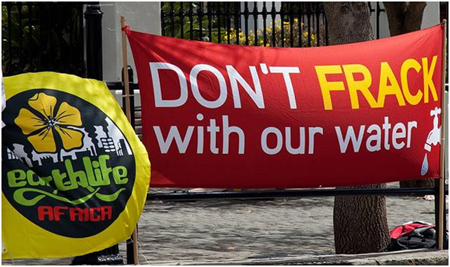Fracking conjures up early discussions of biofuels — an apparent answer to our energy ills, only the impact on the world’s food resources has shown that it is not that simple. In other words, in attempting to respond to one set of problems, it adds another set. So, while fracking could mean a cheaper, reliable energy source and fuel/ power plants built and able to become operational quickly, its environmental impacts are disastrous:
“Fracking is a way of drilling to get at gas trapped in the shale rock found 4-6 km underground. To get to it the drill may pass through water tables. Water mixed with dangerous chemicals is then pumped at high pressure into the drill hole. In the USA these chemicals include highly carcinogenic benzen, toulenc and lead. This cracks the shale and releases the gas. Often there are leaks and in this case, the gas and the chemicals contaminate the ground water. It is a water-intensive activity which makes no sense in a water scarce country. Between 15-20 million litres of water are used each time a well is fracked — and each well can be fracked up to 12 times. At least 35 per cent of the toxic fracking fluid is left underground — and the millions of litres of toxic water that comes to the surface needs to be disposed of somehow. The drilling also causes damage above ground because of all the heavy-duty trucks that are needed — more than 1500 per well.” (Information letter from Earthlife Africa, September 2012)
Earthlife Africa and other groups organized South African protests on September 22 as part of “Global Frackdown- Ban Fracking” day. Protesters in Cape Town outside Parliament and in Durban delivered a clear message to government.

Recent developments around fracking in South Africa drove the protest. Just two weeks earlier, the South African government rescinded an 18-month moratorium on fracking in the Karoo. This moratorium was placed by the Department of Mineral Resources in early 2011, under pressure from the national and international anti-fracking campaign against gas and oil companies including Shell, Falcon Gas and Oil and Sasol’s application for prospecting rights. The government then conducted a “secret investigation process into the merits or otherwise of fracking without consulting or informing the public.” It has now lifted the moratorium while saying its consultation process with the public will proceed in earnest.
As an extremely dry area of the country, the Karoo’s water supplies are already scarce. At a local meeting on fracking, Shell representatives admitted that they do not know where the millions of litres of water will come from for fracking: “Possibilities at this stage included treated surface water (read sewage), deep saline aquifers or seawater trucked in by train.”
Now it is coming to light that not only the Karoo is under threat of fracking. The state-funded Water Research Commission issued a new report that says the government has already issued fracking exploration permits in six of the nine provinces.

The report warns government about the serious risk of water pollution from cancer-causing chemicals and radioactive compounds from future underground “fracking” operations across huge swaths of the country, including:
– “Widespread pollution of groundwater, rivers and lakes with dozens of cancer-causing fracking compounds and other “highly toxic” pollutants such as benzene, hydrochloric acid and isopropanol.
– Accidental release of underground uranium and other radioactive elements into the water and soil.” (Tony Carnie, KZN Fracking Cancer Risk, The Mercury 20 Sept 2012)
So once again, it seems that the South African government is prioritizing the private sector and promoting it as a “water steward,” leaving its citizens even more vulnerable than they were before the government introduced its “solutions”.
What’s Harper up to? Award-winning journalist Karl Nerenberg keeps you in the know. Donate to support his efforts today.




